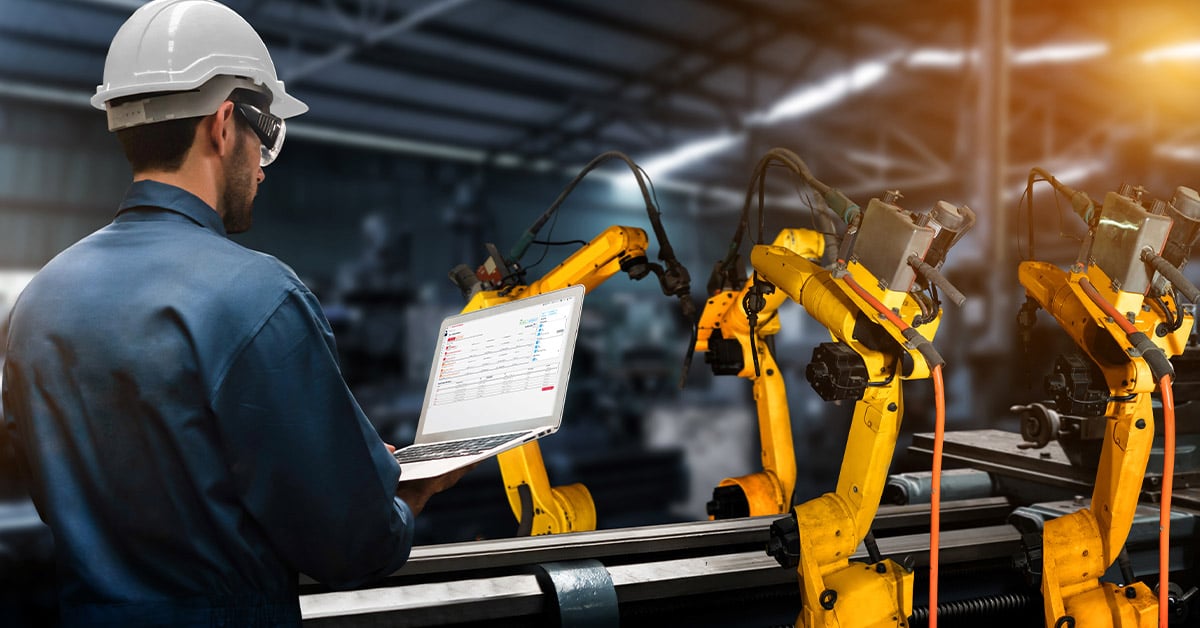How is manufacturing continuing to digitally transform? One aspect is through predictive analytics. As a high-level explanation, predictive analytics is a way of using high-volume data collection (via sensors and network communication) and advanced data analysis to make more informed decisions about processes and operations.
Predictive analytics usage is increasing across all types of industries and businesses, due to the recognition of the strategy’s accuracy and success in improving efficiency, streamlining processes and, overall, improving the bottom line. Predictive analytics in manufacturing is especially useful. In this blog, we will focus on the areas in which industrial predictive analytics can aid manufacturing companies.
Predictive analytics in manufacturing industry applications
How is predictive analytics related to predictive maintenance in manufacturing? Predictive analytics is an underlying technology strategy that informs predictive maintenance — as well as a host of other applications across the industrial landscape. Here, we will look at predictive maintenance analytics, as well as other uses of this technology:
Predictive maintenance: As mentioned, predictive maintenance is a primary use case for predictive analytics. In predictive maintenance, industrial sensors are used to record data points for manufacturing equipment performance (such as temperature and vibration), upload them in real-time and use analytics modeling to identify small fluctuations in performance that may be early indicators of larger potential maintenance problems. These issues can then be proactively addressed well before they lead to equipment malfunctions or shutdowns.
Predictive maintenance also covers areas including the following:
- Inventory ordering and management, with increased insight and accuracy into part usage and requirements.
- Root cause analysis, facilitating more targeted and effective maintenance troubleshooting, saving time and money.
- Predictive asset maintenance analytics, creating more targeted maintenance practices to extend machine and component life.
- Risk analysis, drawing upon broader analytical modeling to go beyond real-time detection of early maintenance issues and make informed assessments of high-risk areas that may come due for unexpected maintenance.
- Macro predictions, predictive analytics can also be useful off the shop floor, in scenarios such as inventory demand forecasting and supply chain management. For example, in manufacturing, raw material sourcing can be one of the most unpredictable and thus costly resource expenditures in production. Sourcing is subject to the whims of the market, which are affected by any number of factors that are difficult to analyze and impossible to control.
- People management, personnel remains the most critical and valuable resource in a manufacturing operation. It is no secret, however, that personnel management is more difficult than ever in the industrial landscape, due to fluctuations in need; difficulty filling positions and keeping them filled; and the everyday requirements of often difficult responsibilities. Predictive analytics has the power to improve all of these areas while creating a more effective workforce, handling everything from standard human resources support to data-centric employee engagement and performance tracking.
Predictive analytics makes use of massive amounts of historical data to make sense of past trends and future likelihoods, finally providing a degree of clarity into a long-opaque process. The use of analytics for demand forecasting draws on similar tactics and can even incorporate technology such as machine learning (ML) to continue improving its predictive accuracy.
Benefits of predictive analytics in manufacturing
With an understanding of what predictive analytics can enable, we will now look at the specific benefits they can offer:
- More equipment uptime: In manufacturing, time is truly money. Equipment downtime — especially when unplanned — has a significant negative impact on project success metrics and the overall bottom line — affecting deadlines, work schedules and balance sheets. Predictive maintenance enables much more control over equipment uptime and downtime, allowing maintenance to be scheduled for times when it will impact production the least.
- More effective inventory management: Inventory is one of the most inefficient areas of manufacturing, quite simply because there always seems to be too much or too little of a given asset on hand. Predictive analytics allows for much more informed inventory decision-making and ordering; facilitating the most effective just-in-time plan possible; and delivering more accurate inventory management than ever.
- More control over seemingly uncontrollable factors: While, of course, no one can predict the future, predictive analytics has the capacity to offer much more informed decision-making. By using big-data tactics and models, predictive analytics can provide a more complete and effective view of forthcoming potential risk factors; opportunities; and recommendations in areas from supply chain to inventory management to demand forecasting and more.
Predictive maintenance solutions and services from ATS
At ATS, we understand the raw power of predictive analytics, and how this strategy can significantly impact the health of your manufacturing equipment and your business as a whole.
Starting with predictive maintenance, we also offer expertise and services for machine health/condition-based monitoring, remote monitoring, and more — making use of industrial sensors and smart technologies to facilitate real-time, informed decision-making — on- and off-site. In today’s environment, that access is critical to the success and reliability of your operations. For more information, contact ATS today.






